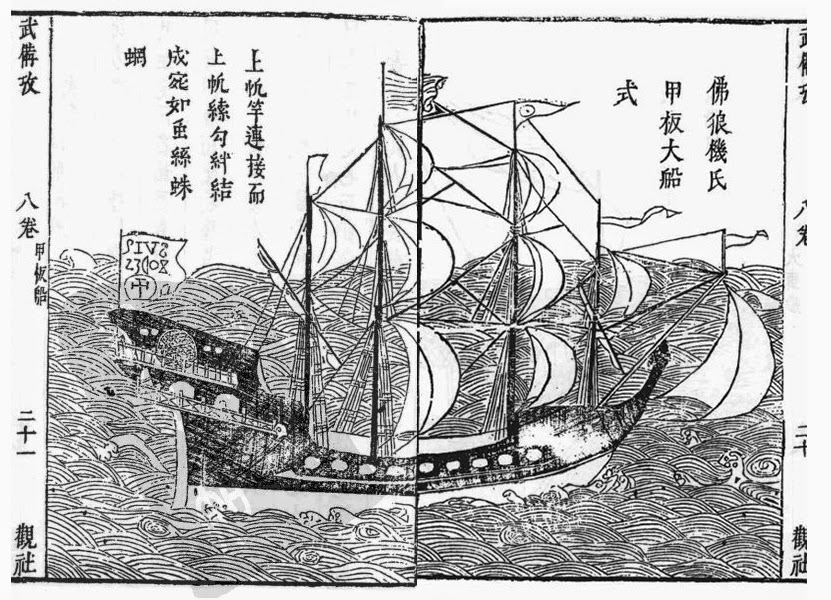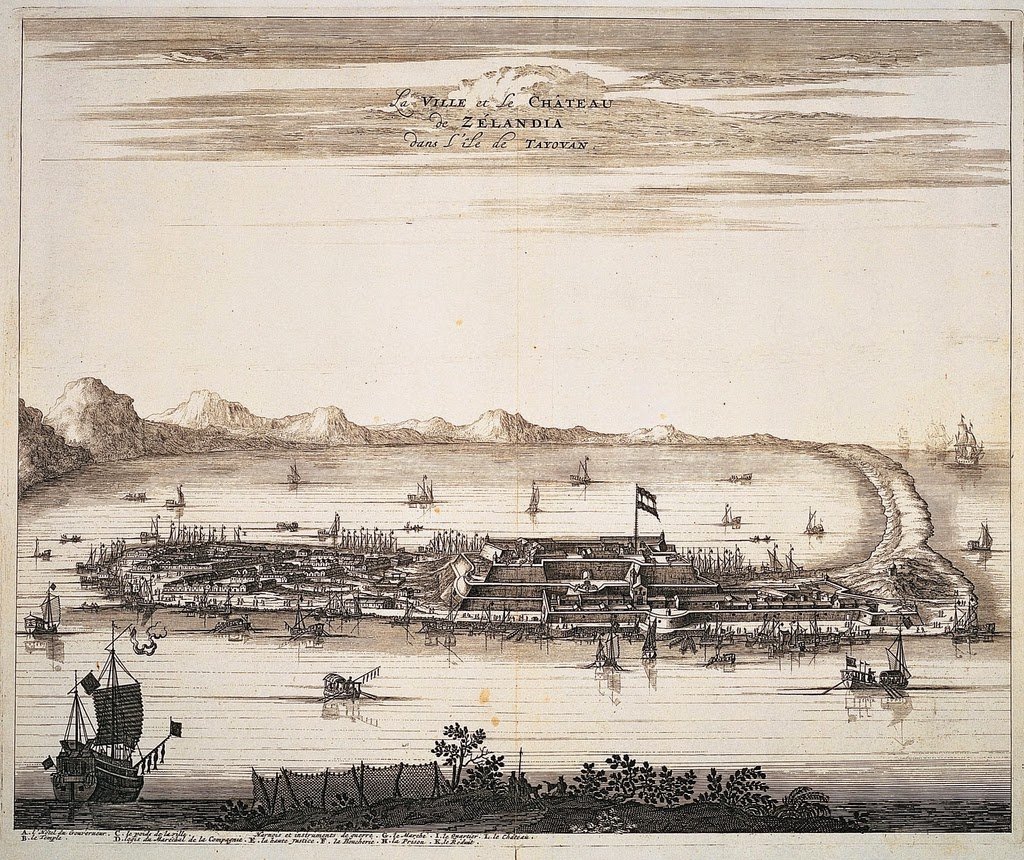 |
| Drawing of a European sailing ship, probably a Portuguese East Indiaman, from 'Jing Guo Xiong Lue (《經國雄略》)'. |
The name
Jia Ban Chuan (夾板船 or 甲板船) comes from the Chinese transcription of Malay word "Kapal", meaning ship. Jia Ban Chuan specifically refers to European great ships of the age of sail. The gigantic size and enormous firepower of European warships outclassed even the strongest of Chinese warships, which impressed the Chinese very much.
Chinese attempt to imitate European design were met with limited success. Ironically, the most successful of these attempts came not from the Ming Dynasty, but from the Chinese pirate-turned-admiral
Zheng Zhi Long (鄭芝龍), also known by his Baptismal name
Nicholas Iquan Gaspard. Unfortunately, Zheng's fleet of European-influenced war junks was destroyed by a Dutch surprise attack before ever seeing combat.
 |
| A giant junk can be seen at the lower left corner of this engraving. LA VILLE ET LE CHATEAU DE ZELANDIA DANS L'ISLE DE TOYOVAN, EN CHINE (1670) c1729. |
Even then, the most powerful of the European-influenced war junks were only the rough equivalent of a fifth-rate ship—powerful enough to go toe to toe against armed merchantmen, escorts and smaller warships of the various East India companies, but still miles behind any serious navy of the European powers.


"The name Jia Ban Chuan (夾板船 or 甲板船) comes from the Chinese transcription of Malay word 'Kapal', meaning ship."
ReplyDeleteI failed to see the connection here (between Jia Ban Chuan and kapal). Do you have any source for this etymology?
In Malay world, "kapal" originally refer to a particular type of ship hailed from India until 17th century (from a word of Dravidian languages, "kappal"). In Malay archipelago a term for ship would be "perahu" or "jong". After the disappearance of the jong (late 1600s or early 1700s), the meaning of perahu would shifted to boat in English, "kapal" took over as the word for ship replacing the word perahu.
What about the Jing Guo Xiong Lue (《經國雄略》), from what year is it?
@Raja Warastra
DeleteGood day and welcome to my blog!
The connection between Jia Ban Chuan and "Kapal" is mentioned in this article:
https://www.researchgate.net/publication/340601426_Contact_Languages_on_the_South_China_Sea_and_Beyond_15_th_-18_th_Centuries
You can read the whole article online.
Ming Chinese generally used the term to refer to Dutch ships. The Dutch came to Ming China in early 1600s, so this should fit with the dates you've given. Pa La Hu Chuan (i.e. perahu) was also adopted by Ming Chinese on an earlier date.
Jing Guo Xiong Lue was published in 1645.
Is there any any more information about the fleet zhang zhilong had built?
ReplyDeleteWe know he lost about 30ish large ships and 20ish smaller ships in the Dutch surprise attack. Considering that he mustered another 150 warships soon after for the counterattack, that might not be all of his ships.
DeleteDo we know how powerful exactly Zhang zhilong's ships are? like how many cannons and size?
ReplyDeleteWe know Zheng Zhilong's ships had "two reinforced cannon decks and could mount thirty or thirty-six large guns".
DeleteSize of the ship is unknown though.
ReplyDeleteYou do realize that before the 1660s warships with more than 50 cannons were extremely rare, almost freaks of nature. The biggest Dutch ship before the 1650s had 46 heavy cannons, so a ship with 36 heavy cannons would be very respectable in the early 17th century. The English considered a ship with 36 big cannons to be a 2nd or 3rd rate in the early 17th century
ReplyDeleteWas it? HMS Sovereign of the Seas had 102 guns and was launched in 1637.
DeleteYes it was! Hundred cannon ships didn't become the naval norm until the early 1700s in European seas. Did you think that a increase in ship size and cannons has come so rapidly? There were only 2 ships with more than 50 cannons until after the 1650s.
DeleteThat's in the Royal English Navy. Other navies before the late 17th century did have over 50 cannon ships but they were very few in number.
DeleteThe other one would be Vasa I suppose?
DeleteThe comparison in my blog post is with "European" ships, not specifically Dutch.
Vasa was 16th century. Some European countries had a few over 50s as a prestige capital ship before the 1660s that is supposed to be the symbolic leader of their entire navy like the French Couronne which had 78 cannon. But the "average" warships had around 30 until later in the 17th century.
DeleteHuh, I mean the Swedish Vasa that sank in 1628.
DeleteWhile >50-gun ships was uncommon in Europe at the time, 36-gun junk wasn't common during late Ming either, so the comparison is apt.
Do you have any information about 火攻撃要 (fire attack ship?) of the West in the Chinese records?
ReplyDeleteHuh? 火攻撃要 is the title of a book.
DeleteSorry, I used google translate. The original paragraph is:
Delete崇祯中,焦勖与汤若望一起编译《火攻挈要》,通过汤若望的集中介绍,焦勖了解了西洋海战中战船火炮的重要作用:“西洋水战所用火攻虽以大铳为本,亦更以坚厚大船为基。海上战船大者长六十丈,阔二十丈;中者长四十丈,阔十二丈;小者长二十丈,阔六丈。底用坚大整木合造,底内四围用铅浇厚尺余。船体分隔上下三层
It's from “船坚炮利”:一个明代已有的欧洲印象
I think I have that book somewhere so I know about it. It's a late Ming military treatise that mostly covers various Hongyi cannons.
Delete